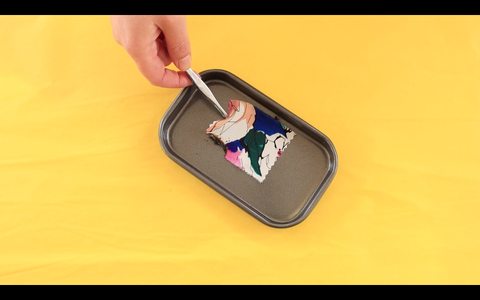We're passionate about fabric at Sew Me Sunshine. Here's our guide to everything silk, and tips on how to sew with this type of dressmaking fabric.
WHAT IS SILK?
Silk is the strongest known natural fibre. It is made up of a natural protein fibre, mainly fibroin, which is a type of protein that certain insect larvae secrete to form a cocoon. Most silk is made from the larvae of a worm that only lives on mulberry trees.

(Image credit: Shuttershock)
HOW DO WE KNOW WE HAVE SILK FABRIC AT SEW ME SUNSHINE?
The majority of the silks sourced at Sew Me Sunshine are ex-designer deadstock fabrics. We always identify our deadstock fabrics by performing a burn test on the fabric. With silk fabrics this is what we find when we do a burn test:
- Burns slowly and flame self extinguishes when it is removed
- Yellow flame and fabric curls away from the flame
- Very little smoke
- Smoke smells of burning hair but less strong than when burning wool
- It leaves dark crushable ash

IS SILK FABRIC ETHICAL?
Many animal rights groups, including PETA argue that the production of silk should be banned. This is because the silkworms are killed during the production of silk. PETA states that 'some 6,600 silkworms are killed to make just 1 kilogram of silk'.
You may come across ahimsa silk also referred to as peace silk, cruelty-free silk or ethical silk. This type of silk was developed in India and manufacturers claim that the cocoons are collected after the moths have emerged meaning that no silkworms are killed during the production. However, there are no certifications in place for this production and thus there is no guarantee that the silk you obtain is 'true' ahimsa silk. Furthermore, it is documented that this silk production method results in lower silk yields which means that the cost of this type of silk is very high. Also, because the silk is obtained from hardened cocoons it results in a rougher fabric finish.
TYPES OF SILK FABRIC?
These fabrics are primarily made from pure silk yarns, though you sometimes find these fabrics are made with other natural and/or synthetic yarns:
- Brocade
- Jacquard
- Velvet
- Cloque
- Taffeta - tightly plain woven crisp fabric
- Satin - woven in a way that enhances the sheen
- Shantung - crisp slubbed silk with a sheen
- Dupion - crisp luxury silk with a slubby texture
- Duchesse - satin medium weight fabric with fine cross ribs
- Chiffon - light fabric made with a tightly twisted single yarn
- Georgette - made in the same way as chiffon but with a two ply yarn
- Tulle - fine transparent net
- Habotai - smooth light semi-sheer plain weave
- Organza - crisp plain weave
- Crepe - pebbly textured woven from high-twist yarns
- Crepe de chine - lightweight plain weave crepe
- Charmeuse - light satin faced with a crepe back

(Images of silk fabrics at Sew Me Sunshine)
WHAT IS SILK NOIL?
Silk Noil (AKA Raw Silk) is made from the short fibres left over from spinning silk. The fibres are short, weaker and considered less valuable than spun silk. Silk noil has a low sheen and a nubby texture and often has slubs and specks throughout it. It is more akin to cotton, so it is easier to sew with than pure silk. This stable drapey fabric is ideal for all sorts of garments such as dresses, blouses, shirts and trousers.

(Image sourced from Pinterest)
ADVANTAGES OF SILK FABRIC:
Smooth and drapes well
One of the strongest natural fibres
Takes dye well
Absorbs and releases moisture quickly
DISADVANTAGES OF SILK FABRIC:
Expensive
Can be difficult to sew with
Tends to shrink
DRESSMAKING PATTERNS FOR SILK FABRIC:
These recommendations do depend on the type of silk fabric you have.
Sequence Blouse / Dress - Papercut Patterns
Nexus Blouse - Papercut Patterns

TOP SEWING TIPS FOR SEWING WITH SILK FABRIC:
- Pre-wash your silk fabric. This is important because it prevents any water marks when you are needing to steam press your garment
- Silk fabric is often lightweight and slippery. To help to stabilise your fabric you could spray your fabric with some spray starch
- Cut your fabric out on the flat (not on the fold)
- Use a sharp pair of scissors or a rotary cutter
- Use fine pins and only pin within the seam allowance
- Hand baste your project if you have time
- Opt for a microtex needle, and a small needle 60/8
- For lightweight thin silk fabric use a smaller stitch length (1.5-2)
- If your sewing machine is sucking the fabric into the machine then you can sew with pattern paper of tissue paper and simply tear it away after you have sewn your seam
- Always test your iron on a scrap of your silk fabric and opt to use a pressing cloth and only iron on the wrong side
- Silk does tend to fray so it is advisable to use French seams, and to finish hems with a rolled hem

---------------
If you have any questions or want to learn more, you can contact Team Sunshine at teamsunshine@sewmesunshine.co.uk.
You can find all of our silk fabrics on our website.
Want to learn more about velvet? Then check out our guide to velvet fabrics here.
Want to learn more about crepe and satin? Then check out our guide to crepe and satin fabrics here.
